Introduction
The Chandra X-ray Observatory (originally called the Advanced X-ray Astrophysics Facility—AXAF) is the X-ray component of NASA’s ”Great Observatory” Program. Chandra is a NASA facility that provides scientific data to the international astronomical community in response to scientific proposals for using it. The Observatory is the product of the efforts of many organizations in the United States and Europe. The Great Observatories also include the Hubble Space Telescope for space-based observations of astronomical objects primarily in the visible portion of the electromagnetic spectrum, the now defunct Compton Gamma-Ray Observatory that was designed to observe gamma-ray emission from astronomical objects, and the soon-to-be-launched Space Infrared Telescope Facility (SIRTF). The Chandra X-ray Observatory (hereafter CXO) is sensitive to X rays in the energy range from below 0.1 to above 10.0 keV, corresponding to wavelengths from 12 to 0.12 nanometers. The relationships among the various parts of the electromagnetic spectrum, sorted by characteristic temperature and the corresponding wavelength, are illustrated in Fig. 1.

Figure 1. The electromagnetic spectrum as a function of temperature and wavelength.
In 1895, the German physicist, Wilhelm Roentgen, discovered what he thought was a new form of radiation. He called it X radiation to summarize its properties. The radiation could pass through many materials that easily absorb visible light and could free electrons from atoms. We now know that X rays are nothing more than light (electromagnetic radiation) but at high quantum energies.
Light has been given many names: radio waves, microwaves, infrared, visible, ultraviolet, X-rays, and gamma radiation are all different forms. Radio waves are composed of low-energy particles of light (photons). Optical photons — the only photons perceived by the human eye—are a million times more energetic than the typical radio photon, whereas the energies of X-ray photons range from hundreds to thousands of times higher than those of optical photons. Very low temperature systems (hundreds of degrees below 0°C) produce low-energy radio and microwave photons, whereas cool bodies like our own (about 30°C) produce infrared radiation. Very high temperatures (millions of degrees Celsius) are one way of producing X-rays.
X-ray astronomy is an extremely important field because it has been found that all categories of astronomical objects (or a subset thereof), from comets to quasars, emit X-rays. Thus learning how and why these objects produce X-rays are fundamental to our understanding of the way astronomical systems work. This, together with the large amounts of energy required to produce X-rays, makes their study interesting and exciting. A second reason that the field is so important is that the vast bulk of the matter in the Universe that we can directly observe through the electromagnetic radiation that it emits is in the very hot (temperatures of millions of degrees) X-ray emitting gas that fills the space between galaxies in clusters of galaxies (Fig. 2), the largest collections of matter in the Universe. The CXO is the prime method of gaining new information about the X-ray emission seen in the Universe.
The field of X-ray astronomy began with the discovery in 1948 that the Sun is a source of X rays. The experiment performed by scientists at the Naval Research Laboratories used photographic film mounted in a V-2 sounding rocket. Earth’s atmosphere absorbs X rays, and so experiments must be performed above it. The first X-rays from a source other than the Sun were detected in 1962 by R. Giacconi and B. Rossi using a Geiger counter in a sounding rocket. For this,and subsequent pioneering efforts including fostering the development of the Chandra X-ray Observatory, Giacconi was awarded half of the Nobel prize for physics in 2002.

Figure 2. The Chandra X-ray image of Hydra A, a galaxy cluster 840 million light years from Earth, shows strands (blue/pink) of 35-40 million degree Celsius gas embedded in a large cloud of equally hot gas (blue) that is several million light years across. A bright white wedge of hot multimillion degree Celsius gas is seen pushing into the heart of the cluster.
Most of the early X-ray astronomy experiments used gas-filled X-ray detectors, either Geiger or proportional counters. Locating the X-ray sources in the sky used mechanical collimation to restrict the field of view to at best about 0.5° (the apparent size of the Sun and the Moon). This crude accuracy made identification of the X-ray sources with objects seen in either the visible or the radio difficult. One notable exception in this early era was an experiment by H. Friedman and colleagues at the Naval Research Laboratories that used lunar occultation to show that the nebula associated with the X-ray pulsar in the Crab Nebula was extended.
X-ray astronomy began to make huge strides due to the development of focusing X-ray optics that could concentrate large amounts of X rays into small areas and form an image. The first X-ray astronomy satellite fully devoted to extrasolar X-ray imaging was NASA’s second High Energy Astronomy Observatory, it was referred to as the Einstein Observatory in the scientific community, and it was launched in 1979. The prototype of the Chandra X-ray Observatory, the Einstein observatory had the first large-area grazing incidence X-ray optics and featured an angular resolution of about 10 seconds of arc, although only a small fraction of the X rays reflected by the telescope was within this central core due to scattering caused by the roughness of the reflecting surfaces.
The next major advance in X-ray focusing was the German/USA/UK mission Rosat (1990-1998; see, e.g., Truemper, 1983). It was equipped with an imaging X-ray telescope of about 4 seconds of arc angular resolution and three interchangeable imaging X-ray detectors, and it made numerous contributions.
The CXO was named in honor of the late Indian-American Nobel laureate, Subrahmanyan Chandrasekhar (Fig. 3), nicknamed ”Chandra” which means ”moon” or ”luminous” in Sanskrit. He was one of the foremost astrophysicists of the twentieth century and, in 1983, was awarded the Nobel prize for his studies of the physical processes important to the structure and evolution of stars.
The Observatory and Its Instrumentation
An artist’s drawing of the CXO is shown in Fig. 4. The CXO has three major parts, as shown in Fig. 5: (1) the X-ray telescope or High-Resolution Mirror Assembly (HRMA), whose mirrors focus X rays from celestial objects; (2) the science instruments—the advanced CCD imaging camera (ACIS) and the high-resolution camera (HRC) that record the X rays and two sets of objective transmission gratings (OTG) discussed below; and (3) the spacecraft, which provides functions such as power and telemetry necessary for the telescope and the instruments to work.

Figure 4. Artists rendering of the CXO.
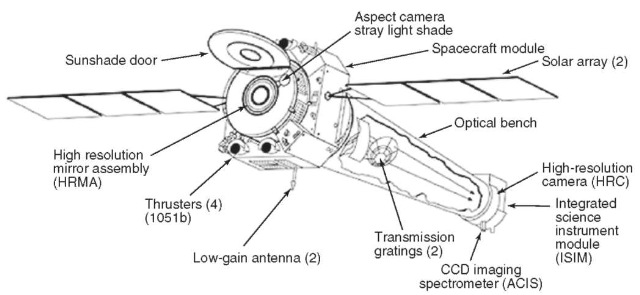
Figure 5. Line drawing of the major components of the CXO.
The building and operation of this 1.5-billion-dollar facility has been a marvel of modern technology and ingenuity. Overall program management and technical and scientific oversight are provided by NASA’s Marshall Space Flight Center. The Marshall Center was ably assisted by the Smithsonian Astrophysical Observatory (SAO). The prime contractor was the company, TRW, Inc., which was responsible for the spacecraft construction and integrating ofall subsystems into the Observatory. Major subcontractors and their principal functions were Raytheon Optical Systems—telescope grinding and polishing; Optical Coating Laboratories, Inc.—telescope coating; Eastman Kodak Corporation—telescope assembly and alignment; Ball Aerospace and Technology Corp.—science instrument accommodation module and aspect system.
The spacecraft systems for the CXO are fairly standard; they have modest (32,000 bits/second) data rates and moderate pointing accuracy and stability. These latter two were feasible by employing an onboard, visible-light-sensitive, aspect camera which is used on the ground after the data are taken to correct the position of the X rays detected to sky coordinates. This is possible because the X-ray cameras on CXO record the position of each X-ray detected.
Because Earth’s atmosphere absorbs X rays, the CXO was placed high above it. This meant that the ultraprecise mirrors and detectors, together with the sophisticated electronics that conveys the information back to Earth, had to withstand the rigors of a rocket launch and operate in the hostile environment of space.
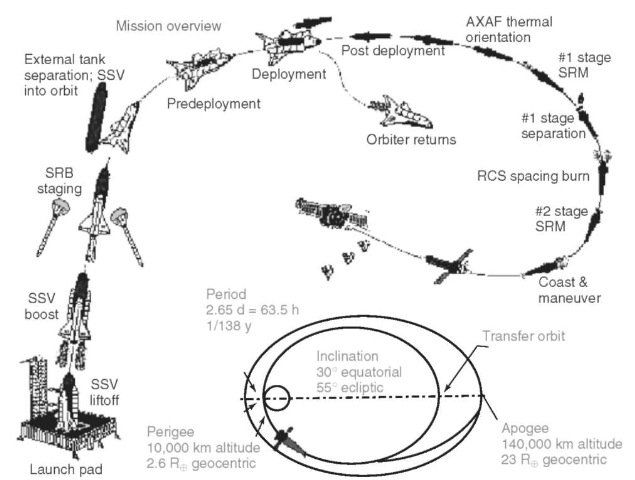
Figure 6. CXO launch sequence and orbit.
Chandra’s unusual orbit, shown in Fig. 6, was achieved after initial deployment by the Space Shuttle Columbia, Eileen Collins (Fig. 7) commanding. This particular Shuttle launch was especially noteworthy because Commander Collins was the first female commander. Initial deployment was followed by a boost into a high Earth orbit by an inertial upper stage built by the Boeing Corporation. Final placement into the orbit used a built-in propulsion system. The orbit, which has the shape of an ellipse, takes the spacecraft more than a third of the way to the moon before returning to its closest approach to Earth, 10,000 kilometers (6,214 miles). The time to complete an orbit is about 65 hours. The spacecraft spends about 75% of its orbit above the belts of charged particles that surround Earth. Uninterrupted observations as long as 55 hours are possible.
Because of their high quantum energy, X rays do not easily reflect from mirrors. However, reflection can take place when the angle of incidence is shallow. This property can be exploited to build optical systems that can bring X rays to a common focus. A particular design, that used for the CXO, is illustrated in Fig. 8. The design, referred to as a Wolter type 1, uses a paraboloid of revolution followed by a hyperboloid of revolution—two reflections are necessary to bring objects away from the axis of symmetry into focus. Nesting several of these pairs of paraboloids and hyperboloids increases efficiency for collecting X rays. The CXO has four such systems whose diameters range from 0.65 m (2.13 ft) to 1.2 m (3.94 ft). Each optical element is 0.84 m (2.75 ft) long. The elements are constructed of Zerodur, a glassy ceramic, and together weigh more than 2000 pounds.

Figure 7. Commander Eileen Collins.
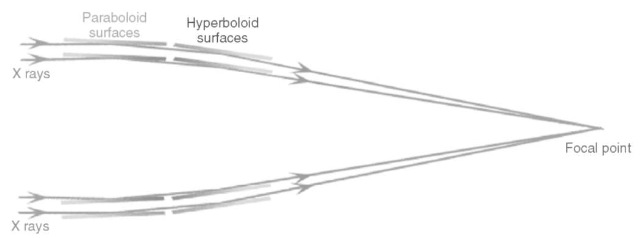
Figure 8. Illustration of a cross section of two nested, Wolter I, X-ray optics.
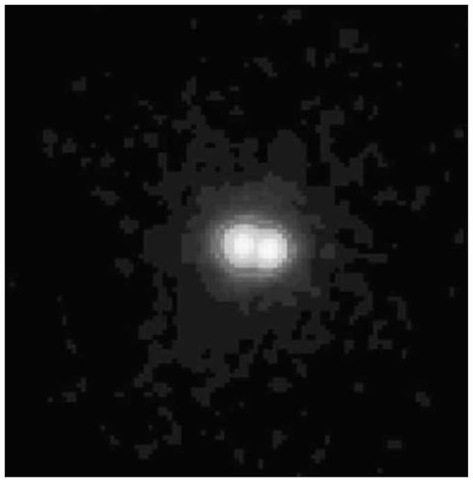
Figure 9. Chandra’s image of what had been a puzzling X-ray source in the globular star cluster M15 shows that it is not a single system but two sources that are so close together (2.7 seconds of arc) that they were undistinguished by previous X-ray telescopes.
The most unique attributes of the CXO X-ray optics, those that makes this observatory so powerful, are the angular resolution (the ability to distinguish two separate objects very close to each other) and the high efficiency by which photons are collected within the narrow spot that defines its ability to resolve different objects. This high efficiency results from the smoothness of the X ray reflecting surfaces so that the X-rays are not scattered from the intended path. The angular resolution is better than 0.5 seconds of arc, that is, the letters of an X-ray-emitting STOP sign can be distinguished at a distance of 12 miles! The surface roughness is measured in angstroms. If the state of Colorado were as smooth as Chandra’s mirrors, Pike’s Peak would be less than 1 inch tall. The angular resolution of Chandra is significantly better than any previous, current, or even currently planned X-ray observatory. Figures 9 and 10 and illustrate the utility of the superb angular resolution and low scattering.
The science instruments aboard the Observatory and the organizations that led their development are the advanced CCD imaging spectrometer (ACIS)— Penn State University and the Massachusetts Institute of Technology (MIT); the high-resolution camera (HRC)—Smithsonian Astrophysical Observatory (SAO); the high-energy transmission grating (HETG)—MIT; and the low-energy transmission grating (LETG)—Space Research Institute of the Netherlands and the Max Planck Institute for Extraterrestial Physics in Garching, Germany.
Either (but not both simultaneously) of the two transmission gratings can be commanded in place directly behind the telescope. When in position, X rays are diverted (dispersed) according to their energy, along one dimension, from their normal path. The X-ray image now represents, to a high degree of accuracy, the energy of the incident photons. Determining the energy is called spectroscopy.
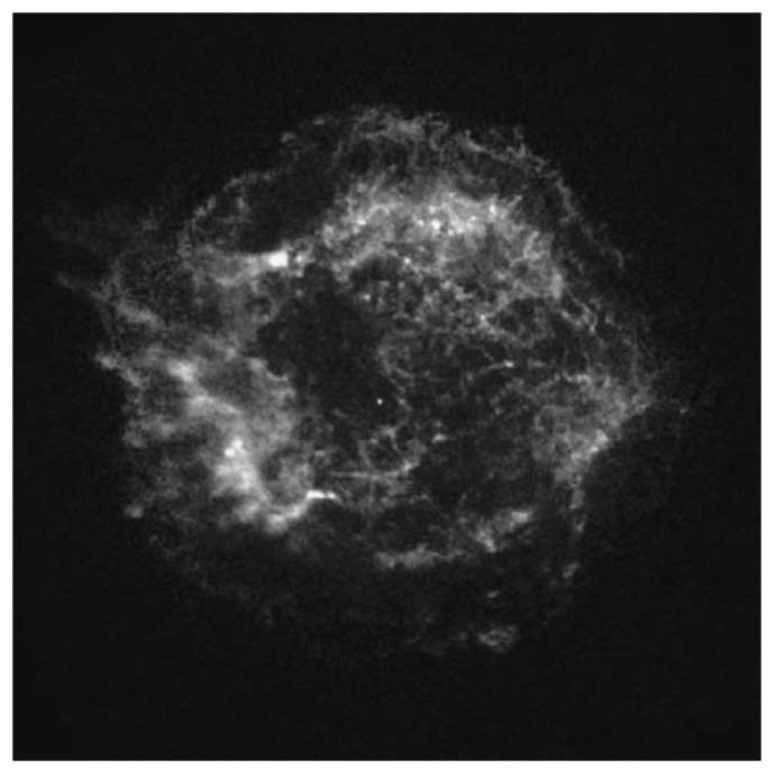
Figure 10. Chandra image of the supernova remnant Cassiopeia-A based on about three-quarters of an hour of data. The point source at the center, previously undetected, simply leaps out of the Chandra image
The ACIS detectors record X-ray images and can, to a certain degree, also determine the energy of the incident X-ray but not as well as the gratings. The spectroscopic advantage of the ACIS detectors is that they are far more efficient for detecting X rays when the gratings are not in place. There are two ACIS detectors; either can be placed at the focus of the telescope by command. The ACIS-I is made of a 2 x 2 array of front-illuminated (FI), 2.5-cm-square, X-ray sensitive, charge-coupled devices (CCDs) analogous to those found in visible-light-sensitive digital cameras. ACIS-I provides high-resolution spectrometric imaging across a 17-arcmin-square field of view. ACIS-S, a 6 x 1 array of 4 FI CCDs and two back-illuminated CCDs, is mounted along the dispersion direction of the transmission gratings and serves both as the primary read-out detector for the HETG, and, using one of the back-illuminated CCDs that can be placed at the aim point of the telescope, also provides high-resolution spectrometric imaging extending to lower energies, but across a smaller (8-arcmin-square) field than the ACIS-I.
As in the ACIS, there are two HRC detectors that may be moved into place to record X-ray images. Both are microchannel-plate detectors that consist of millions of tiny tubes of cesium-iodide-coated glass. These detectors record the position of the X rays, but unlike the ACIS, can barely distinguish energies. The HRC-I array is a 10-cm square plate that has a field of view of 31 arcmin square. Comprising three rectangular segments (3 x 10 cm each) and mounted end-to-end along the dispersion direction, the HRC-S serves as the primary read-out detector for the LETG. A important advantage of the HRC for certain scientific experiments is its ability to determine the time when the X-ray event was detected to high a much higher precision (microseconds) than achievable with the ACIS (milliseconds).
Scientific Results
X rays are produced by highly energetic processes—thermal processes in plasmas at temperatures of millions of degrees—or non thermal processes, such as synchrotron emission (realized when charge particles are accelerated by magnetic fields) or scattering of visible light or radio waves from very hot electrons. Consequently, X-ray sources are frequently exotic: supernova explosions and remnants, whose explosion shocks the ambient interstellar medium or a pulsar, a rotating neutron star, powers the emission; disks of accreting nearby material or jets around stellar-mass neutron stars or black holes; accretion disks or jets around massive black holes in the nucleus of galaxies; hot gas in galaxies and in clusters of galaxies that traces the gravitational field and can be used to determine the mass. These are all examples of sites of, and methods for, producing X rays. Here we give several examples of observations by the CXO that illustrate its capability for investigating these processes and objects.
Chandra’s capability for high-resolution imaging enables studies of the structure of extended X-ray sources, including supernova remnants (see Fig. 10),astrophysical jets (Fig. 11), and hot gas in galaxies and clusters of galaxies (Fig. 2). The capability for spectrometric imaging allows studies of structure in X-ray intensity and also in temperature and chemical composition. Through observations by Chandra, scientists have begun to address several of the most exciting topics in contemporary astrophysics.

Figure 11. This Chandra image, 24 arc seconds on a side, shows details in the powerful jet shooting from the quasar 3C273, providing an X-ray view into the area between 3C273′s core and the beginning of the jet.
Comets and Planets. Besides the Sun, which is too bright to be observed safely by the Observatory, other known X-ray sources in our solar system include Earth, the Moon, Venus, Jupiter and some of its moons, and comets. The X-rays from the Moon, Venus and, to a certain extent, Earth are due to the fluorescence of solar X rays that strike the atmosphere. The discovery image of X-ray emission from Venus (Fig. 12) by Chandra shows a half crescent due to the relative orientation of the Sun, Earth, and Venus. Solar X-rays are absorbed in the Venusian atmosphere above the surface of the planet that knock electrons out of the inner parts of atoms and excite the atoms to a higher energy level. The atoms almost immediately return to their lower energy state and emit a characteristic or “fluorescent” X-ray. Similarly, ultraviolet light produces the visible light of fluorescent lamps. The origin of the X-ray emission from Jupiter (Fig. 13) is more complex and not completely understood. Important ingredients are the presence of a magnetic field and rotation of the planet. Studies using Chandra should help provide a better understanding of the physical processes involved. Normal Stars. The CXO has optical instrumentation aboard that provides an ”aspect solution,” which shows where the observatory was pointing during an observation to an accuracy of about 1 second of arc. However, it is usual for Chandra observations to detect the X-ray emission from several stars that have much more accurate cataloged positions based on their optical emission. Using the stellar positions as a local reference, the remaining X-ray sources in the field can be positioned far more precisely to about 0.2 to 0.4 seconds of arc. One example of using such positions is the determination of the positions of the more than 1000 X-ray sources in the Orion Nebula star cluster (Fig. 14). It is interesting that this single Chandra image contains more X-ray sources than had been detected in the first 15 years of X-ray astronomy. The Orion Trapezium, a region only 3 light years across at the core of the Orion Nebula star cluster, contains very young stars and therefore offers astronomers a view into a region where stars are born. The cluster is composed of stars whose a median age is only around 300,000 years, and, at a distance of 1400 light years, is one of the nearest star-forming regions. The CXO was used to identify X-ray emission from individual stars and found that almost all of these young stars were much hotter than expected.
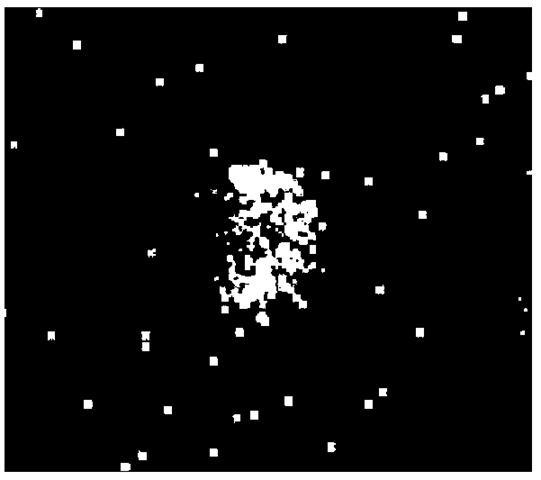
Figure 12. Chandra image, the first X-ray image ever of Venus, shows a half crescent due to the relative orientation of the Sun, Earth, and the planet—the Sun is to the right. X-rays from Venus are produced by fluorescent radiation from oxygen and other atoms in the atmosphere about 130 kilometers above the surface.
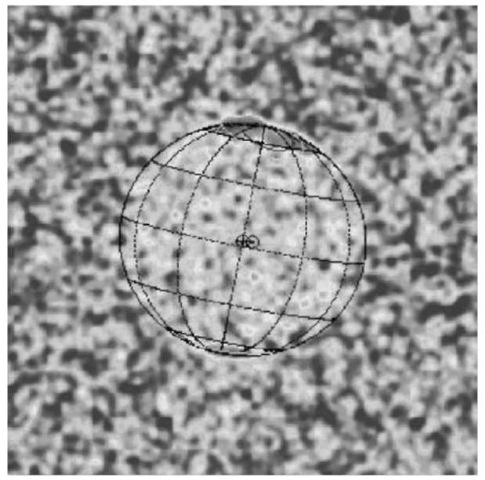
Figure 13. Chandra image of X-ray emission from Jupiter. The red colors indicate the highest intensity. The bulk of the emission takes place near the magnetic poles.
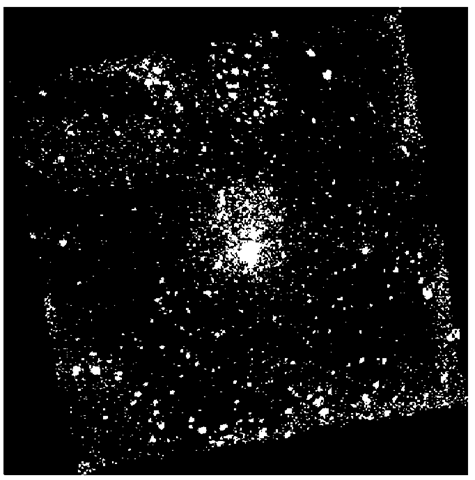
Figure 14. The CXO image of the Orion star cluster. The region shown in this image is about 10 light years across. The bright stars in the center are part of the Trapezium, an association of very young stars whose ages are less than a million years.
The Center of Our Galaxy. Precise positioning was critical for the unique identification of the X-ray emission from the object known as Sagittarius A*, the source at the extremely crowded center of our own Milky Way galaxy (Fig. 15). This source is a moderately small black hole of about 3 million solar masses, and is very faint compared to other galactic nuclei. X rays are emitted just beyond the horizon within which no light can escape, and thus the black hole may be “seen.” A bright flare was detected by the CXO on 27 October 2000, whose X-ray intensity increased by more than a factor of 10 for about 3 hours and then rapidly dipped on a timescale of 10 minutes. The rapid variation in X-ray intensity indicates that the flare was due to material as close to the black hole as Earth is to the Sun. This is compelling evidence that matter falling toward the central black hole is fueling energetic activity at the center of our galaxy. Supernova Remnants. Another example of Chandra’s ability to provide high-contrast images is exemplified by the now classic image of the remains of the remnant formed by the implosion of a star, a supernova, called the Crab Nebula and its compact core, a rotating neutron star that pulses. The image (Fig. 16) shows the intricate structure produced by the pulsar interacting with the local environment. This image is not static; observations by the CXO spaced out over time have shown the dynamic motions that take place as a result of the interaction of the pulsar at the center of the remnant and the local environment.
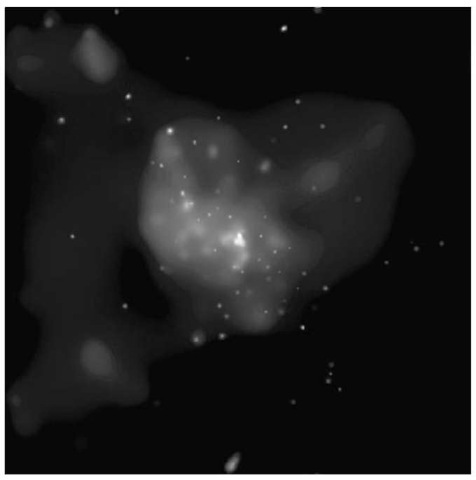
Figure 15. The ACIS-I image of the galactic center. This image shows the central region of our Milky Way Galaxy as seen by the CXO. The bright, point-like source at the center of the image was produced by a huge X-ray flare that occurred in the vicinity of the black hole at the center of our galaxy.
Globular Clusters. One of the most striking examples of the power of Chandra X-ray imaging is in the spectacular Chandra images of globular clusters. Figure 17 is an ACIS-I image of the globular cluster 47 Tucanae. The left panel is composed of red/green/blue images derived from X rays recorded in different energy bands and shows the central portion of the cluster. The enlargement at the right is the central core. Some 108 sources, excluding the central core, are detected. This number is more than ten times that found by previous X-ray satellites.
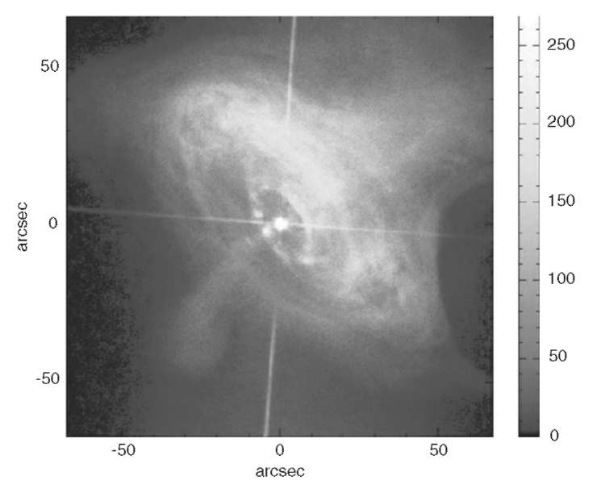
Figure 16. Chandra image of the Crab pulsar and nebula made using the LETGS and the HRC-S. The nearly horizontal line in the figure is a cross-dispersed spectrum of the pulsar produced by the LETG fine support bars. The nearly vertical line is the LETG-dispersed spectrum from the pulsar.
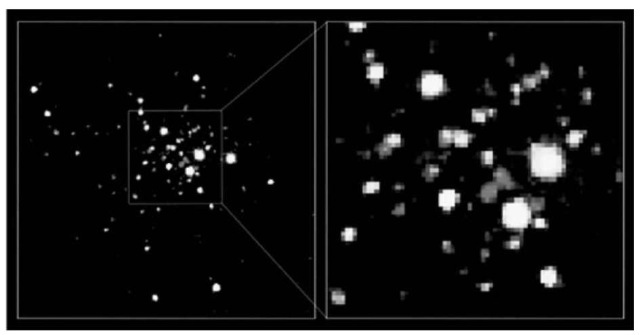
Figure 17. Chandra image of 47 Tucanae. The left image covers the central 2′ x 2.5′. The further enlargement of the central region to the right is 35” x 35”. The different colors represent the dominant X-ray energy range: low-energy X-ray emission (red), intermediate-energy X-ray emission (green), and high-energy X-ray emission (blue). The white sources are bright in each of these ranges. The faint red sources are mostly millisecond pulsars, whereas the bright white sources are mostly binaries containing white dwarfs that produce X-rays by pulling matter from normal stars.
These Chandra images of 47 Tucanae provided the first complete census of the brighter X-ray producing stars in the core of the globular cluster. As the oldest stellar systems in galaxies, globular clusters are laboratories for stellar evolution. Nearly all objects in the Chandra images are ”binary systems,” in which a normal, Sun-like star orbits a collapsed star, either a white dwarf or neutron star from which X-rays are emitted. The data also reveal the presence of many ”millisecond pulsars,” neutron stars that rotate extremely rapidly between 100 to nearly 1000 times a second.
The image, associated spectra, and measured time variability reveal more about the binary content and stellar, as well as dynamic, evolution of a globular cluster than achieved by all previous X-ray observations of globular clusters combined.
Normal Galaxies. In addition to mapping the structure of extended sources and the diffuse (extended) emission due to the presence of hot gas in galaxies, the high angular resolution of the CXO permits studies of ensembles of discrete sources, which would otherwise be impossible owing to the large number of sources crowded together in a small region of the sky (source confusion). A beautiful example comes from observations of the center of the Andromeda galaxy (M31) shown in Fig. 18. The image shows what used to be considered the emission associated with the black hole at the center that is now resolved into five distinct sources. A most interesting consequence is that the emission from the region surrounding the central black hole is unexpectedly faint relative to the mass, as in the Milky Way.
M81 (NGC 3031) is a spiral galaxy at a distance of approximately 3.6 Mpc. The galaxy was observed by using the ACIS-S instrument on Chandra (Fig. 19). Previously, the galaxy had been observed using both the Einstein and Rosat X-ray observatories, and about 30 sources had been detected. This Chandra observation detected 97 X-ray sources, 41 in the bulge of the galaxy and 56 sources in the disk. Twenty-one of these latter sources were close to, or in, the spiral arms. The sheer number of X-ray sources detected by Chandra in a typical nearby galaxy makes studies of the global properties of X-ray source populations possible.
In many galaxies, observations using Chandra have detected one or more sources which are so bright that if truly associated with the galaxy and if the emission is not highly beamed, then the object must have a mass substantially greater than that of a neutron star and is thus likely to be a black hole whose mass is more than 25 times the mass of the Sun. Such “ultraluminous” sources appear to be quite common in nearby galaxies, and there are too many of examples of such objects to give much credence to the idea that they are all more local than one might think. If they are local (closer), then they are not nearly so powerful as they appear and would not be considered ”ultraluminous.” Because of the ubiquity, the concept of an intermediate-mass black hole is gaining some acceptance. Lower mass black holes are born in explosions of massive stars (supernova); very high mass (hundreds of thousands of solar masses or larger) black-holes are born in (form in) the nuclei of galaxies. Precisely how an ”intermediate-mass” black hole is created is not completely understood.
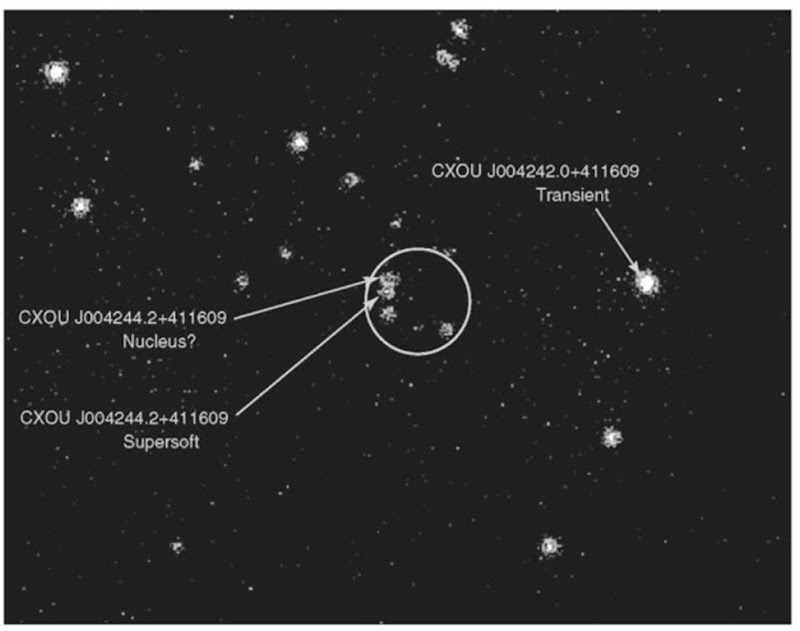
Figure 18. Central region of M31 observed with the ACIS-I. The circle is 5 arcseconds in radius and illustrates the previous location of the X-ray nucleus. The old X-ray nucleus is resolved into five individual sources, and the source labeled CXO J004244.2 + 411609 is within 0.15 arcseconds of the black hole at the center of the galaxy.
Quasars. Quasars look like normal stars through an optical telescope. Not until the 1950s, when radio astronomy was first developed, did astronomers discover that these objects were well outside our own galaxy and were therefore emitting massive amounts of radio energy. These objects are called “quasars,” short for ”quasi-stellar radio sources.” Quasars are among the most distant, energetic objects ever observed. Individual quasars are brighter than hundreds of galaxies put together, yet many are smaller than the size of our own solar system. Radio astronomers use a system of numbers to name objects in the sky. 3C273 was named in the 3rd Cambridge catalog as the 273 rd radio source identified. 3C273, along with 3C48, were the first quasars to be identified as such. These objects had bizarre optical spectra unlike any ever studied before. In 1963, astronomers Maarten Schmidt (3C273) and Jesse Greenstein and Thomas Matthews (3C48) noticed that these spectra made sense only if the objects were simply moving away from us, thus causing the apparent wavelengths to shift to the longer (redder) wavelengths (hence redshift)—in the case of 3C273 at about one-tenth the speed of light. Quasars are now considered a subset of active galaxies (called active galactic nuclei or AGN) powered by the presence of a massive black holes at their centers.
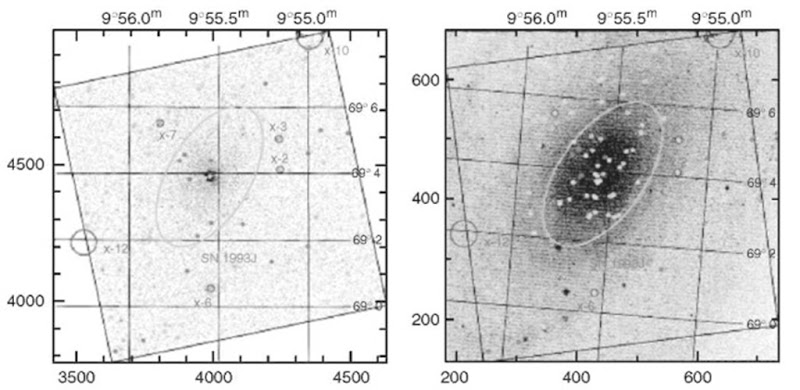
Figure 19. Chandra observations of M81. Left: X-ray image with contours. Right: X-ray contours on optical image.
More detailed and modern studies of quasars show that there are high-powered jets associated with these objects and often the material in the jets moves at velocities very close to the speed of light. Exactly how this happens is a topic of major astrophysical interest. Furthermore, instead of seeing a smooth stream of material driven from the core of the quasar, most optical, radio, and X-ray observations have revealed inconsistent, “lumpy” clouds of gas. The Chandra image (Fig. 11) of 3C273, however, shows, for the first time, a continuous X-ray flow emanating from the core. One would like to learn how and why matter is so violently ejected from near the quasar’s core. The energy emitted probably comes from gas that falls toward the supermassive black hole at the center of the quasar but is channeled by strong electromagnetic fields. The black hole itself cannot be observed directly, but scientists hope to discern properties of the black hole by studying the jet.
Clusters Of Galaxies. Chandra observations of clusters of galaxies frequently show us structures that have characteristic angular scales of a few arcseconds. Before Chandra, it was thought that the X-ray emission from galaxy clusters arose from a fairly simple system. The Hydra A radio galaxy (3C 218), shown in Fig. 2, was observed early in the Chandra mission. This very early image shows large areas of low X-ray brightness, indicating the presence of regions of low density or cavities in the hot gas. Similar, but even more dramatic cavities were found in the Perseus cluster shown in Fig. 20.
The X-ray Background—the Chandra Deep Surveys
The first sounding rocket flight in 1962 that detected the brightest X-ray source in the sky, other than the Sun, also detected a general background of X radiation (Giacconi et al., 1962). Since this first experiment, the detailed nature of the background radiation had been a puzzle. The lack of any distortion of the energy spectrum of the much cooler cosmic microwave background could be used to eliminate the possibility that the X-ray background glow was truly diffuse (Mather et al., 1990). Thus, the glow must have consisted of sources so faint as to be unresolved by the telescopes of the time. The question remained—what faint sources were contributing to this backgound glow? Observations by previous X-ray satellites such as ROSAT were a major step in resolving a significant fraction (about 75%) of the glow at low energies into discrete objects (Hasinger et al., 1998) and found that the sources reside mainly in active galaxies at red-shifts from 0.1 to 3.5. The Japanese ASCA satellite observations extended the search for sources in the 2-10 keV band and resolved about 30% of the background glow (Ueda et al., 1998).
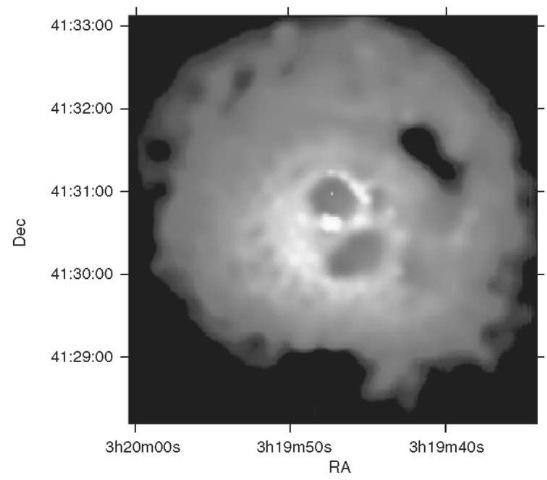
Figure 20. Chandra image of the X-ray core of the Perseus cluster of galaxies.
Chandra is ideally suited to search for faint sources. Two very deep exposures, one of one million, the other of two million seconds have been accomplished to date. These exposures are referred to as the Chandra Deep Fields. A portion of the image of one, the Chandra Deep Field North, is shown in Fig. 21. About 350 sources were detected in each of the one-million-second surveys. The most distant source detected (so far) is a quasar at a redshift of 5.2. The majority of the X-ray sources beyond a redshift of 0.5 are active galaxies that have massive black holes at their centers. The Chandra deep surveys extend the study of the background to signals levels more than an order of magnitude below that which could be previously achieved and have confirmed that most of this background is due to a variety of different types of discrete sources. At very low energies, there is somewhat diffuse component that results from warm-hot intervening matter (referred to as WHIM), concentrated regions of matter that formed in the early stages of the Universe when the first galaxies and galactic clusters formed.

Figure 21. Chandra ”true -color” ACIS image of the Chandra Deep Field North. This image has been constructed from the 0.5-2.0 keV band (red) and 2.0-8.0 (blue) images. Part of the Chandra Deep Field North has also been surveyed in visible light using the Hubble Space Telescope, and this region is shown in outline.
The spectrum of the X-ray background had also been considered puzzling because it was found that the majority of the bright AGN have an energy spectrum different from that of the background itself. One of the purposes of the Chandra Deep Surveys has been to explore the spectra of the sources, because the faint sources must modify the spectrum from the average of the bright AGN sample. The faint source spectrum was estimated by adding the spectra of individual sources detected in the surveys. This has now been accomplished and the paradox resolved (see, e.g., Rosati et al., 2002).
Sources of Gamma-Ray Bursts. Cosmic gamma-ray bursts (GRBs) were discovered in the late 1960s by satellites designed to detect gamma rays produced by atomic bomb tests on Earth. The bursts appear as a brilliant flash of gamma rays that lasts seconds to minutes. The bursts are often, but not always, followed by afterglows observable at X-ray (always), optical, and radio wavelengths (sometimes). Using one of the experiments on the Compton Gamma-Ray Observatory, astronomers took an important step in understanding the sources of these bursts by determining that the objects that produce them are not in our own galaxy. This discovery implied that the sources of these bursts are extremely energetic. The source of this tremendous energy is unknown. Models currently in vogue involve a fireball of energy where matter moves at nearly the speed of light. The source of this rapidly moving matter is unknown; theories include the merging of neutron stars, or black holes, or the collapse of an extremely massive star.
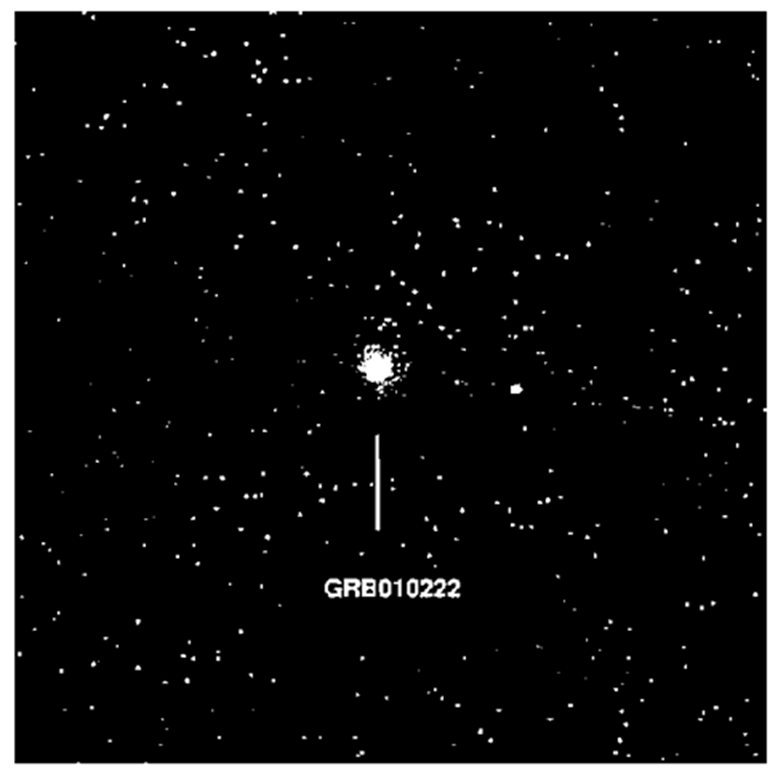
Figure 22. Chandra image of the X-ray afterglow from gamma-ray burst GRB010222.
The CXO is being used to help to solve the mystery of gamma-ray bursts by studying X-ray afterglow (Fig. 22). An example of this is the Chandra observation of the gamma-ray burst that took place on 22 February 2001. The Chandra data supported the model in which a very massive star has exploded, a “hypernova.”
High-Resolution Spectroscopy. Owing to their unprecedented clarity, Chandra images are visually striking and provide new insights into the nature of X-ray sources. Equally important are Chandra’s unique contributions to high-resolution dispersive spectroscopy. High-resolution X-ray spectroscopy is the essential tool for diagnosing conditions in hot plasmas. It provides information for determining the temperature, density, elemental abundance, and ionization stage of X-ray emitting plasma. The excellent spectral resolution of the Chandra gratings isolates individual spectral lines (i.e., features at specific energies), which would overlap at lower resolution. The spectral resolution also enables the determination of flow and turbulent velocities, by measuring Doppler shifts, shifts in the apparent energy, and the widths of the lines produced by these motions. Spectroscopy using the CXO gratings achieves its best energy resolution for nonextended (point) sources. Thus, observations that use the Chandra grating have concentrated on, but are not limited to, X-ray emission from the hot regions surrounding stars (stellar coronae), X-ray sources in binary systems, and active galactic nuclei.
Web Site
The official CXO site on the World Wide Web is http://www.chandra.harvard.edu. This site has numerous Chandra images, as well as information about the Observatory and X-ray astronomy.
